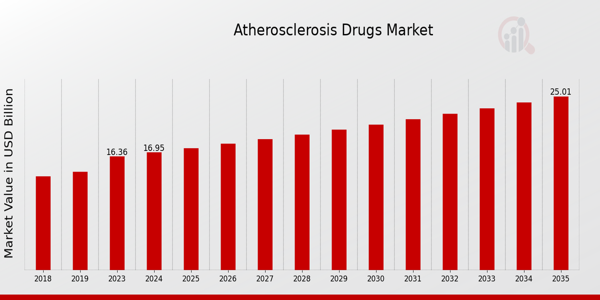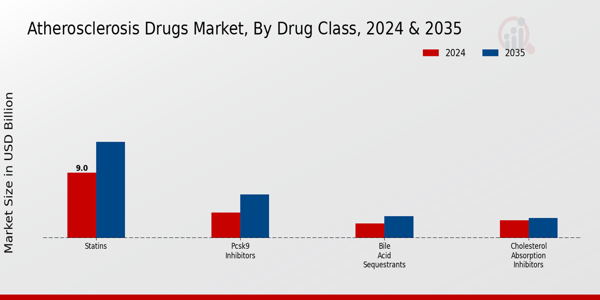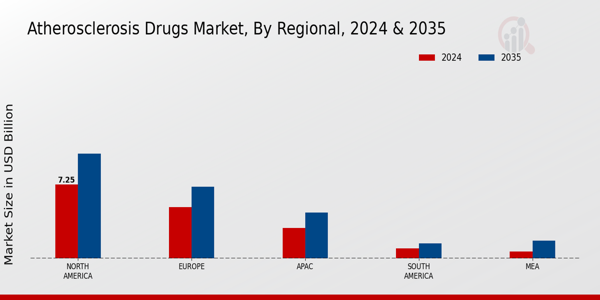Atherosclerosis Drugs Market Overview
As per MRFR analysis, the Atherosclerosis Drugs Market Size was estimated at 16.36 (USD Billion) in 2023. The Atherosclerosis Drugs Market is expected to grow from 16.95 (USD Billion) in 2024 to 25.0 (USD Billion) by 2035. The Atherosclerosis Drugs Market CAGR (growth rate) is expected to be around 3.6% during the forecast period (2025 - 2035).
Key Atherosclerosis Drugs Market Trends Highlighted
The growth in cardiovascular disease incidence, which has raised awareness and encouraged proactive risk management, is fueling the global market for atherosclerosis drugs. This rise is a result of aging populations, poor lifestyles, and rising rates of diabetes and obesity.
Pharmaceuticals that help control cholesterol levels, lessen plaque development, and enhance general cardiovascular health are in greater demand as a result of individuals and healthcare professionals looking for efficient therapies.
Technological and drug development advancements have enabled researchers to design novel treatments, which has further fueled market expansion. Opportunities within this market are significant, especially with the rise of personalized medicine and biological therapies.
Companies can capitalize on this trend by investing in research and development to create targeted treatments that cater to individual patient needs. The expansion of telemedicine and digital health solutions also presents an avenue to enhance patient engagement and medication adherence.
Additionally, emerging markets show potential for growth as healthcare infrastructures improve, offering new avenues for drug distribution and patient education on atherosclerosis prevention and management. Recent trends indicate a shift toward combination therapies that tackle multiple risk factors simultaneously.
The focus on prevention strategies and lifestyle modifications is becoming increasingly integrated into treatment plans. Moreover, there is a growing emphasis on long-term management, moving beyond mere symptom relief to addressing root causes through continuous care.
Pharmaceutical companies are exploring partnerships with technology firms to integrate health monitoring solutions, fostering a more holistic approach to atherosclerosis treatment. This connectivity enhances outcomes and reflects a broader movement toward improved healthcare experiences.
As the market evolves, these drivers, opportunities, and trends will shape the future landscape of atherosclerosis drug development and accessibility.

Source: Primary Research, Secondary Research, MRFR Database and Analyst Review
Atherosclerosis Drugs Market Drivers
Increasing Prevalence of Atherosclerosis and Related Health Issues
The Global Atherosclerosis Drugs Market is significantly driven by the increasing prevalence of atherosclerosis and related cardiovascular diseases. Atherosclerosis, characterized by the buildup of plaque in the arteries, is becoming more common globally due to lifestyle choices, unhealthy diets, sedentary behavior, and rising obesity rates.
As the global population ages, the incidence of risk factors like hypertension and diabetes further exacerbates the situation. This rising prevalence translates into a greater demand for effective therapeutic options, propelling the growth of the Global Atherosclerosis Drugs Market.
Furthermore, patients diagnosed with atherosclerosis often require long-term medication to manage their conditions and reduce the risk of serious complications such as heart attacks and strokes. Healthcare systems across the world are focusing on providing better treatment options, leading to increased investment in research and development for innovative drugs.
The heightened focus on cardiovascular health by governments and health organizations also plays a crucial role in raising awareness about atherosclerosis, ultimately contributing to the expansion of the Global Atherosclerosis Drugs Market.
Advancements in Drug Development
Innovations in drug development are a significant market driver in the Global Atherosclerosis Drugs Market. The pharmaceutical sector is continuously evolving, with new therapeutic agents being developed to target atherosclerosis more effectively.
Advancements in biotechnology and pharmaceutical research have paved the way for the introduction of novel drugs, such as PCSK9 inhibitors and monoclonal antibodies, which have shown promising results in clinical trials.
These advancements not only enhance the treatment landscape but also attract investment and collaboration from major pharmaceutical companies. The ongoing research for better efficacy and safety profiles promotes the growth of the atherosclerosis drugs market.
Increasing Healthcare Expenditure
Rising healthcare expenditure across various regions is another important driver impacting the Global Atherosclerosis Drugs Market. As healthcare systems improve and evolve, there is a greater allocation of funds towards managing chronic diseases, including atherosclerosis. This surge in spending enables better access to medications and treatment options for patients.
Moreover, the increasing focus on preventive healthcare and early intervention strategies encourages patients to seek diagnosis and treatment sooner, thus enhancing the demand for atherosclerosis drugs. It reflects a broader societal trend towards improving health outcomes, significantly benefiting the Global Atherosclerosis Drugs Market.
Atherosclerosis Drugs Market Segment Insights
Atherosclerosis Drugs Market Drug Class Insights
The global atherosclerosis drugs market, particularly within the drug class segment, presented significant insights driven by various therapeutic options aimed at managing atherosclerosis and associated cardiovascular diseases.
The Drug Class segmentation identified key contributors such as Statins, PCSK9 Inhibitors, Bile Acid Sequestrants, and Cholesterol Absorption Inhibitors, each playing a vital role in improving patient outcomes.
Statins emerged as the dominant class with a valuation of 9.0 USD Billion in 2024, accounting for a significant majority of the market, underscoring their established efficacy and widespread prescription for lowering cholesterol test levels and reducing cardiovascular events.
PCSK9 Inhibitors, holding a valuation of 3.5 USD Billion in 2024, represented a growing segment that offers innovative treatment options for patients who are statin-resistant or have familial hypercholesterolemia. The relatively higher cost of these biologics indicated their premium positioning in the market and reflects rising trends towards personalized medicine.
On the other hand, Bile Acid Sequestrants, valued at 2.0 USD Billion, and Cholesterol Absorption Inhibitors, at 2.45 USD Billion, provided alternative treatment pathways albeit at a smaller scale. These segments, while not dominating the market, contributed meaningfully by serving a niche that catered to patients who experienced side effects from more conventional therapies like Statins.
By 2035, notable growth is also projected across these segments, emphasizing the ongoing evolution and increasing expansion of treatment landscapes in the Global Atherosclerosis Drugs Market.
Market dynamics, including an aging population, rising sedentary lifestyles, and the growing prevalence of metabolic disorders, continue to drive demand for these drug classes, while healthcare advancements provide new opportunities for innovation and improved treatment modalities.
The combination of an expanding market, evolving patient preferences, and technological advancements are crucial factors shaping the landscape of the Global Atherosclerosis Drugs Market, thus indicating robust potential and promising growth across all key drug classes in the foreseeable future.

Source: Primary Research, Secondary Research, MRFR Database and Analyst Review
Atherosclerosis Drugs Market Route of Administration Insights
The Global Atherosclerosis Drugs Market is experiencing significant growth as it evolves to address varying patient needs, with the Route of Administration segment playing a crucial role in this landscape.
Oral administration remains a key player, as it is preferred by many patients for its convenience and ease of use, potentially driving substantial market demand. Injectable forms also hold a significant portion of the market due to their rapid onset of action and suitability for patients who may have difficulty with oral medications.
Further, transdermal administration is gaining traction, particularly for patients requiring steady drug release over an extended period. Each of these administration routes caters to different patient demographics and treatment protocols, enhancing adherence and overall effectiveness.
The diverse methods not only provide flexibility in treatment options but also influence the overall Global Atherosclerosis Drugs Market revenue as healthcare providers continue to prioritize patient-centric approaches in managing this chronic condition.
The ongoing trends towards personalized medicine create ample opportunities, with manufacturers investing in innovative delivery systems to meet the evolving demands of the market. As the Global Atherosclerosis Drugs Market statistics reveal, understanding these dynamics is essential for stakeholders aiming to navigate the competitive landscape successfully.
Atherosclerosis Drugs Market Therapeutic Area Insights
The Global Atherosclerosis Drugs Market generates significant revenue, driven by the increasing prevalence of cardiovascular diseases around the world.
The segmentation of the Global Atherosclerosis Drugs Market highlights key areas such as hypertension, hyperlipidemia, and diabetes, each contributing in different capacities to the overall market dynamics. Hypertension plays a crucial role, as high blood pressure is a major risk factor for atherosclerosis, thus creating a substantial demand for effective treatment options.
Hyperlipidemia, characterized by elevated lipid levels, also dominates the market, linked to significant cardiovascular complications, prompting ongoing innovation and demand for targeted therapies. Additionally, diabetes is increasingly recognized for its substantial impact on cardiovascular health, leading to heightened focus and efforts in drug development aimed at managing related risks.
These segments collectively reflect the rising awareness and need for efficient treatment solutions, presenting both opportunities and challenges for market players navigating the evolving landscape of the Global Atherosclerosis Drugs Market. The market is poised for growth, supported by advancements in drug formulations and an expanding patient base seeking effective management of these conditions.
Atherosclerosis Drugs Market End User Insights
The Global Atherosclerosis Drugs Market has shown considerable growth, especially within the End User segment, which includes diverse categories such as hospitals, pharmacies, and home care.
Hospitals play a crucial role, as they are often the primary setting for the diagnosis and management of atherosclerosis, providing advanced care and treatment options. Pharmacies are equally significant, serving as accessible points for patients to obtain medications and advice on managing their conditions, contributing to the market's expansion.
The homecare sector has witnessed increased importance, driven by an aging population and a shift towards at-home management of chronic conditions, enabling patients to receive care in more comfortable settings.
Trends such as the rising prevalence of metabolic disorders and the growing awareness of cardiovascular health are driving the Global Atherosclerosis Drugs Market revenue across all end-user channels. As healthcare evolves, these segments present opportunities for further innovation and public health improvements, ensuring individuals have the necessary access to effective treatment.
The Global Atherosclerosis Drugs Market statistics highlight the ongoing potential for growth as healthcare providers adapt to the changing landscape of patient needs and treatment strategies.
Atherosclerosis Drugs Market Regional Insights
The Global Atherosclerosis Drugs Market was marked by substantial regional variations, with North America holding the majority with a valuation of 7.25 USD Billion in 2024 and projected to rise to 10.25 USD Billion by 2035. This dominance was largely due to advanced healthcare infrastructure and high prevalence of atherosclerosis in the region.
Europe followed, with a significant valuation of 5.0 USD Billion in 2024, growing to 7.0 USD Billion in 2035, driven by increasing awareness of cardiovascular diseases and a strong pharmaceutical market. The APAC region, valued at 3.0 USD Billion in 2024 and expected to reach 4.5 USD Billion by 2035, showed promising growth, supported by rising healthcare expenditures and an increasing aging population.
South America and MEA were comparatively smaller markets, with South America starting at 1.0 USD Billion in 2024 and MEA at 0.7 USD Billion, anticipated to grow to 1.5 USD Billion and 1.75 USD Billion respectively by 2035. These regions represented emerging markets where there was increasing investment in healthcare infrastructure, offering opportunities for growth.
The Global Atherosclerosis Drugs Market statistics underscored the diverse dynamics across these regions, influencing the overall market growth and segmentation.

Source: Primary Research, Secondary Research, MRFR Database and Analyst Review
Atherosclerosis Drugs Market Key Players and Competitive Insights
The Global Atherosclerosis Drugs Market operates within a competitive landscape characterized by the continuous evolution of therapeutic options and innovation in treatment strategies. As prevalence rates of atherosclerosis rise globally, pharmaceutical companies are increasingly focused on developing and marketing drugs that reduce cardiovascular risk and improve patient outcomes.
The competition is influenced by factors such as intensive research and development, strategic collaborations, regulatory approvals, and market trends driven by the demand for effective therapies. Key players are strategically positioning themselves through the introduction of novel drug formulations, leveraging advanced technology, and tailoring approaches based on demographic needs.
Analyzing this market necessitates a profound understanding of the competitive dynamics that shape company strategies and influence patient access to vital therapies. Roche holds a significant position in the Global Atherosclerosis Drugs Market, enhancing its market presence through a robust portfolio of innovative therapies that address the complexities of atherosclerosis.
The company’s research and development efforts focus on targeted treatment options that improve the therapeutic landscape. Roche’s strengths lie in its comprehensive pipeline, which includes molecules in various stages of development aimed at different aspects of atherosclerosis management.
With a commitment to advancing precision medicine, Roche successfully integrates its capabilities in diagnostics with therapeutics, which further strengthens its competitive identity.
The company’s established relationships with healthcare providers and payers also enhance its market penetration, allowing it to provide comprehensive solutions that meet patient needs while navigating healthcare systems effectively.
Regeneron Pharmaceuticals has carved out its niche in the Global Atherosclerosis Drugs Market by focusing on innovative treatments that address significant unmet clinical needs related to cholesterol management and cardiovascular health.
The company is recognized for its strong analytical approach to drug development, which enables it to deliver therapies that demonstrate meaningful efficacy and safety profiles. Regeneron Pharmaceuticals is well-regarded for its collaboration-driven strategy, which includes partnerships that extend its research capabilities and market reach.
Its distinctive focus on biologics and genetic insights positions Regeneron uniquely within the market, providing it with the technological edge to pursue complex targets that traditional therapies may overlook. This enables Regeneron to maintain a competitive edge while its commitment to clinical excellence drives its efforts to enhance treatment options for patients suffering from atherosclerosis.
Key Companies in the Atherosclerosis Drugs Market Include
- Roche
- Regeneron Pharmaceuticals
- Amgen
- Johnson and Johnson
- Merck and Co
- Pfizer
- Eli Lilly
- BristolMyers Squibb
- Boehringer Ingelheim
- AbbVie
- Sanofi
- Novartis
- AstraZeneca
- Gilead Sciences
Atherosclerosis Drugs Market Developments
Recent developments in the Global Atherosclerosis Drugs Market have shown a robust trajectory, influenced by ongoing innovations and strategic collaborations among leading companies such as Roche, Regeneron Pharmaceuticals, Amgen, Johnson & Johnson, and Merck & Co.
With increasing investments in research and development, these firms are advancing novel therapeutic options aimed at combating cardiovascular diseases. Merger and acquisition activity has also been notable, with significant movements within these companies, further solidifying their market presence while enhancing their research capabilities.
For instance, Eli Lilly's recent acquisition strategies have expanded its portfolio in the atherosclerosis segment, while Pfizer and Bristol-Myers Squibb continue to explore partnerships aimed at accelerating drug development. Additionally, companies like AstraZeneca and Sanofi are witnessing growth in market valuation, reflecting positively on their stock performance and overall market confidence.
These enhancements in market valuation are anticipated to drive further investment in technologies and products aimed at addressing unmet clinical needs in the atherosclerosis domain, emphasizing the importance of strategic positioning within this evolving landscape.
Atherosclerosis Drugs Market Segmentation Insights
Atherosclerosis Drugs Market Drug Class Outlook
- Statins
- PCSK9 Inhibitors
- Bile Acid Sequestrants
- Cholesterol Absorption Inhibitors
Atherosclerosis Drugs Market Route of Administration Outlook
- Oral
- Injectable
- Transdermal
Atherosclerosis Drugs Market Therapeutic Area Outlook
- Hypertension
- Hyperlipidemia
- Diabetes
Atherosclerosis Drugs Market End User Outlook
- Hospital
- Pharmacy
- Homecare
Atherosclerosis Drugs Market Regional Outlook
- North America
- Europe
- South America
- Asia Pacific
- Middle East and Africa
| Attribute/Metric Source: |
Details |
| MARKET SIZE 2023 |
16.36(USD Billion) |
| MARKET SIZE 2024 |
16.95(USD Billion) |
| MARKET SIZE 2035 |
25.0(USD Billion) |
| COMPOUND ANNUAL GROWTH RATE (CAGR) |
3.6% (2025 - 2035) |
| REPORT COVERAGE |
Revenue Forecast, Competitive Landscape, Growth Factors, and Trends |
| BASE YEAR |
2024 |
| MARKET FORECAST PERIOD |
2025 - 2035 |
| HISTORICAL DATA |
2019 - 2024 |
| MARKET FORECAST UNITS |
USD Billion |
| KEY COMPANIES PROFILED |
Roche, Regeneron Pharmaceuticals, Amgen, Johnson and Johnson, Merck and Co, Pfizer, Eli Lilly, BristolMyers Squibb, Boehringer Ingelheim, AbbVie, Sanofi, Novartis, AstraZeneca, Gilead Sciences |
| SEGMENTS COVERED |
Drug Class, Route of Administration, Therapeutic Area, End User, Regional |
| KEY MARKET OPPORTUNITIES |
Aging population increasing atherosclerosis prevalence, Rise in research funding and investment, Growing demand for personalized medicine, Advancements in biotechnology for drug development, Expanded access to healthcare services |
| KEY MARKET DYNAMICS |
Rising prevalence of cardiovascular diseases, Increasing geriatric population, Growing demand for preventive therapies, Advancements in drug formulations, Strong pipeline of novel therapies |
| COUNTRIES COVERED |
North America, Europe, APAC, South America, MEA |
Frequently Asked Questions (FAQ) :
The Global Atherosclerosis Drugs Market is expected to be valued at 16.95 USD Billion in 2024.
By 2035, the Global Atherosclerosis Drugs Market is projected to reach a value of 25.0 USD Billion.
The expected CAGR for the Global Atherosclerosis Drugs Market from 2025 to 2035 is 3.6%.
North America holds the largest market share with a valuation of 7.25 USD Billion in 2024.
The European market for Atherosclerosis Drugs is expected to grow to 7.0 USD Billion by 2035.
The market size for Statins is expected to be valued at 9.0 USD Billion in 2024.
Major players in the market include Roche, Regeneron Pharmaceuticals, Amgen, and Pfizer.
The market size for PCSK9 Inhibitors is expected to grow to 6.0 USD Billion by 2035.
The Atherosclerosis Drugs Market in the APAC region is expected to be valued at 3.0 USD Billion in 2024.
Opportunities and trends driving growth in the Atherosclerosis Drugs Market include the increasing prevalence of cardiovascular diseases and advancements in drug formulations.
















